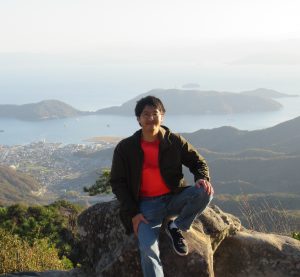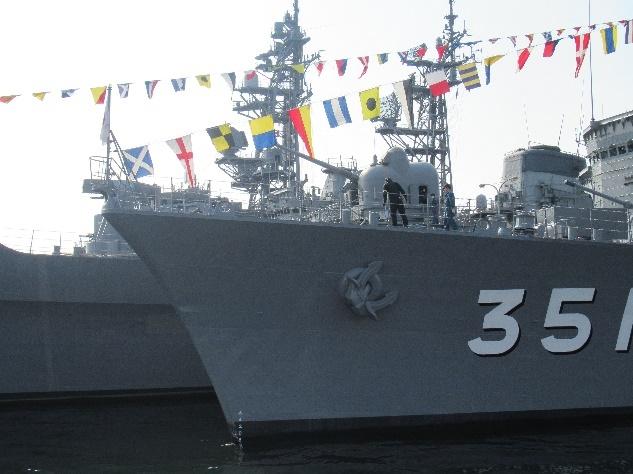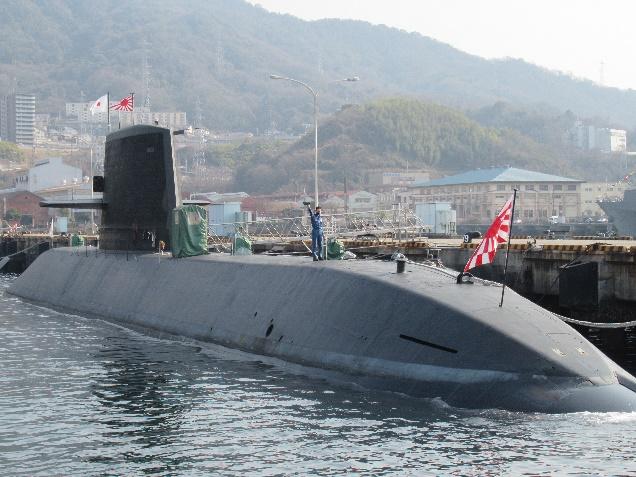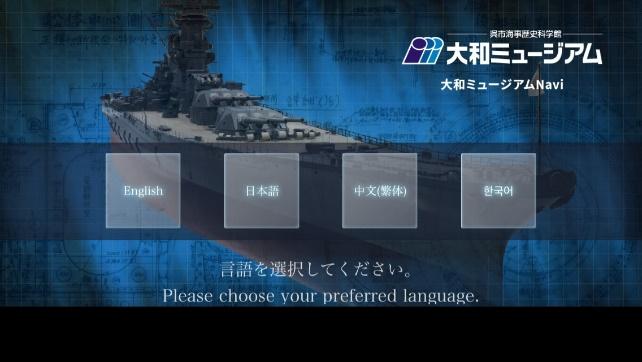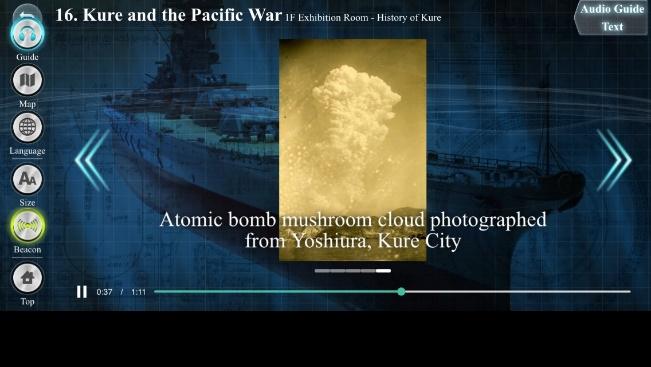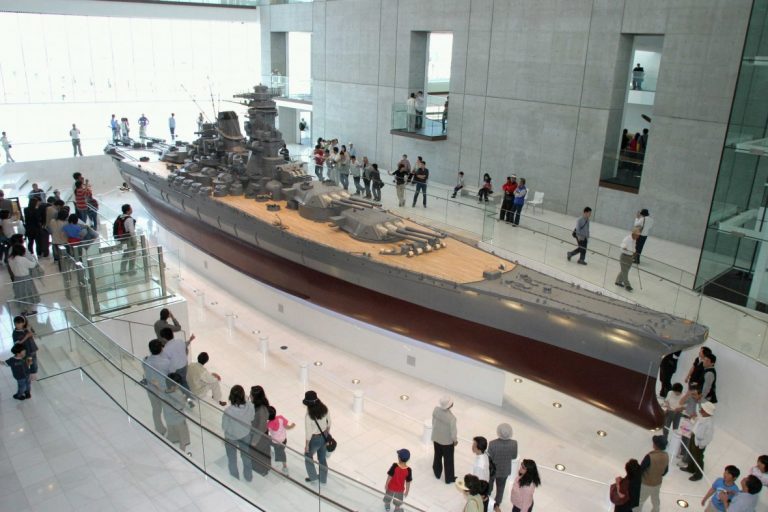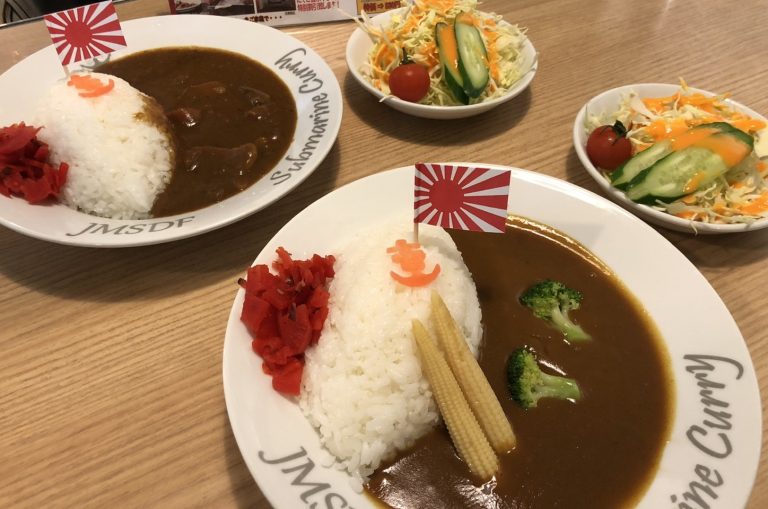100 Stories
Maritime Kure: Defending Japan Then and Now
During World War II, Hiroshima was subjected to one of the most gruesome onslaughts in history in the form of the first atomic bomb used in actual combat. The neighboring city of Kure, being a militarily strategic location, was also one of a great many Japanese cities subject to Allied air raids that demolished naval facilities, dropped mines into the Seto Inland Sea, and sunk countless ships in the harbor. Surrounded by mountains on three sides and meeting the sea on the fourth made Kure naturally fortifiable, and having an abundance of freshwater thanks to its rivers made it worth protecting. Thus, it was only logical for the Japanese Empire to establish a major naval district there, making Kure a prime target for bombing in World War II. In fact, it was initially one of seventeen prospective locations considered when pondering where to drop the atomic bombs, alongside Tokyo Bay, Kawasaki, Yokohama, Nagoya, Kyoto, Osaka, Kobe, Hiroshima (actually bombed), Yamaguchi, Shimonoseki, Kokura (present-day Kitakyushu), Yahata (present-day Kitakyushu), Fukuoka, Sasebo, Nagasaki (actually bombed), and Kumamoto. A city of such importance in the vicinity of Hiroshima ought to be an integral component of anybody’s tour of Hiroshima, so I took it upon myself to comb through Kure’s sights and uncover the treasures of this harbor that are regrettably overshadowed by its once-vaporized neighbor.
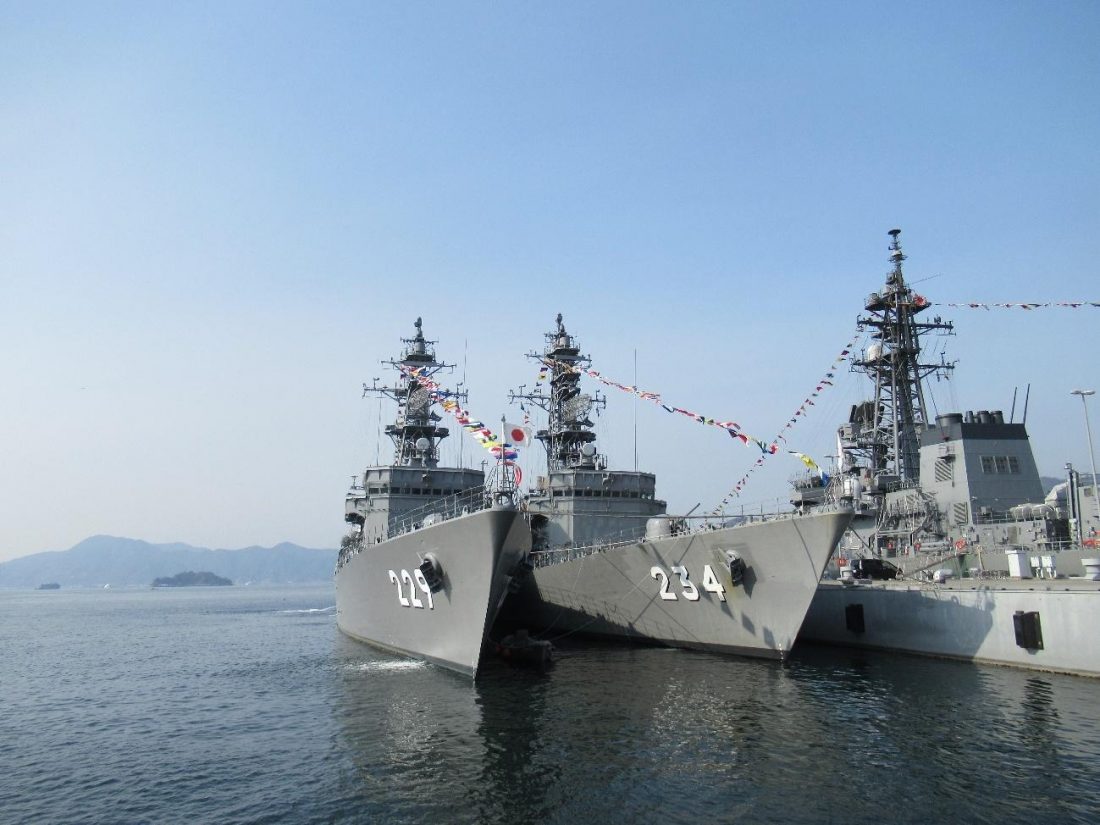
Kure can be effortlessly accessed via a single train ride from Hiroshima Station on the Kure Line, which can take anywhere between thirty minutes to an hour depending on the time of day one boards. If going from downtown Hiroshima like me, you may opt for the streetcar to reach Hiroshima Station or take the Eki-machi Loop bus line. The Eki-machi Loop starts and ends at Hiroshima Station, with two sets of buses weaving through the center of town; one going clockwise, the other going counterclockwise. If you’re around Hatchobori, a clockwise bus will get you there faster, but if you’re close to Peace Boulevard, going counterclockwise may be your best bet. It’s the cheapest bus available and costs the same as the streetcar, but goes faster.
The area around Kure Station is also a significant transportation hub, featuring bus lines that serve the surrounding area and ferries that take travelers to Matsuyama on Shikoku, Etajima’s Koyo Port, and Ujina Port in Hiroshima. However, the primary tourist attractions in Kure are in close proximity to the station and can be reached in a ten-minute walk. Upon exiting the station, stay on the skybridge—which will take you through the YouMe Town shopping mall—until you reach the harbor.
Dive! Dive! Dive!
As soon as I exited YouMe Town, I looked to my right and could make out a colossal, beached iron whale. This is the site of the Japan Maritime Self-Defense Force Kure Museum, colloquially referred to as the “Iron Whale Museum” because of the decommissioned Akishio submarine placed next to the building. Admission is free, and visitors even get a chance to enter the submarine itself from the third floor.
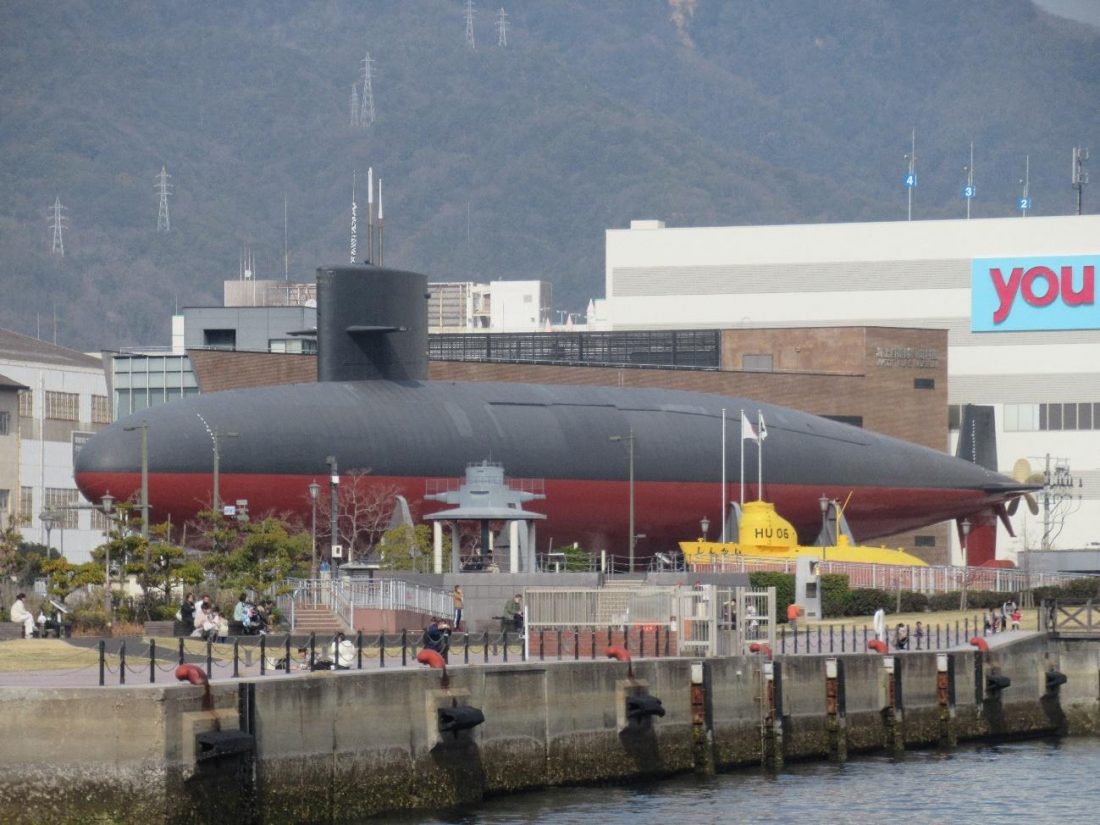
I got my pamphlet at the reception counter and immediately began exploring the history of the JMSDF. The first floor has some brief explanations entailing the beginnings of the JMSDF as well as their functions today, but the exhibition truly begins after taking the escalator to the second floor. The focus here was on the JMSDF’s involvement and tactics in minesweeping the Seto Inland Sea. Mines dropped around Kure during World War II continued to float or dwell at the bottom of the sea for a long time, and cleanup was a tedious and life-threatening task that took decades to complete. In addition to plaques and videos detailing the story of minesweeping, the museum also has naval mines and minesweeping equipment on display, such as the diver suits of people brave enough to approach and detect mines underwater, and a machine gun used to safely detonate surface mines.
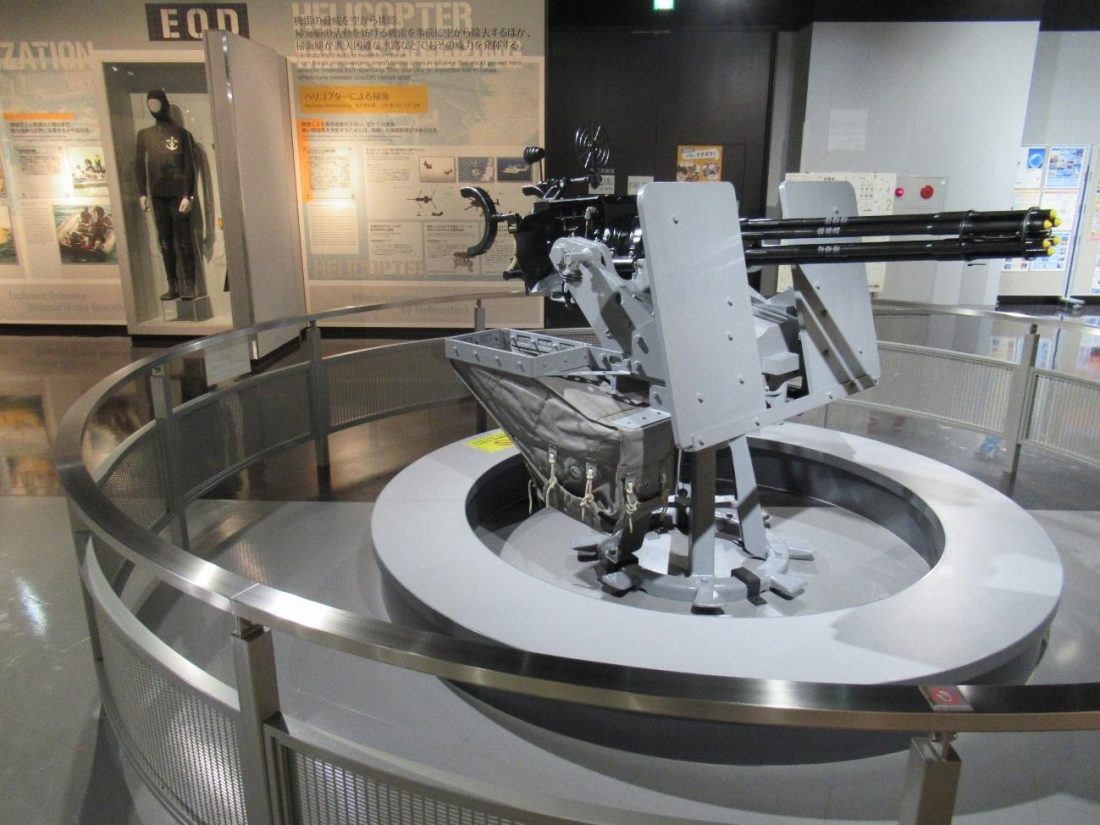
The third floor dives into the history of submarine warfare in Japan, accompanied by miniature models of past submarines and thorough, bilingual explanations on their numerous features. They also had some spaces showcasing the crew’s quotidian lifestyle with fake foodstuffs and equipment. For instance, members of the JMSDF who depart for long journeys on submarines will start to forget the days of the week. I have a friend in the JMSDF who can confirm this; there are no windows or clocks onboard, and submariners aren’t allowed to have their phones or watches on them, so they have no way of keeping track. To remedy this, the galley serves curry and rice every Friday to remind the seamen what day of the week it is. Did you have curry yesterday? If so, today is Saturday. Was curry on the menu three days ago? That means it’s Monday.
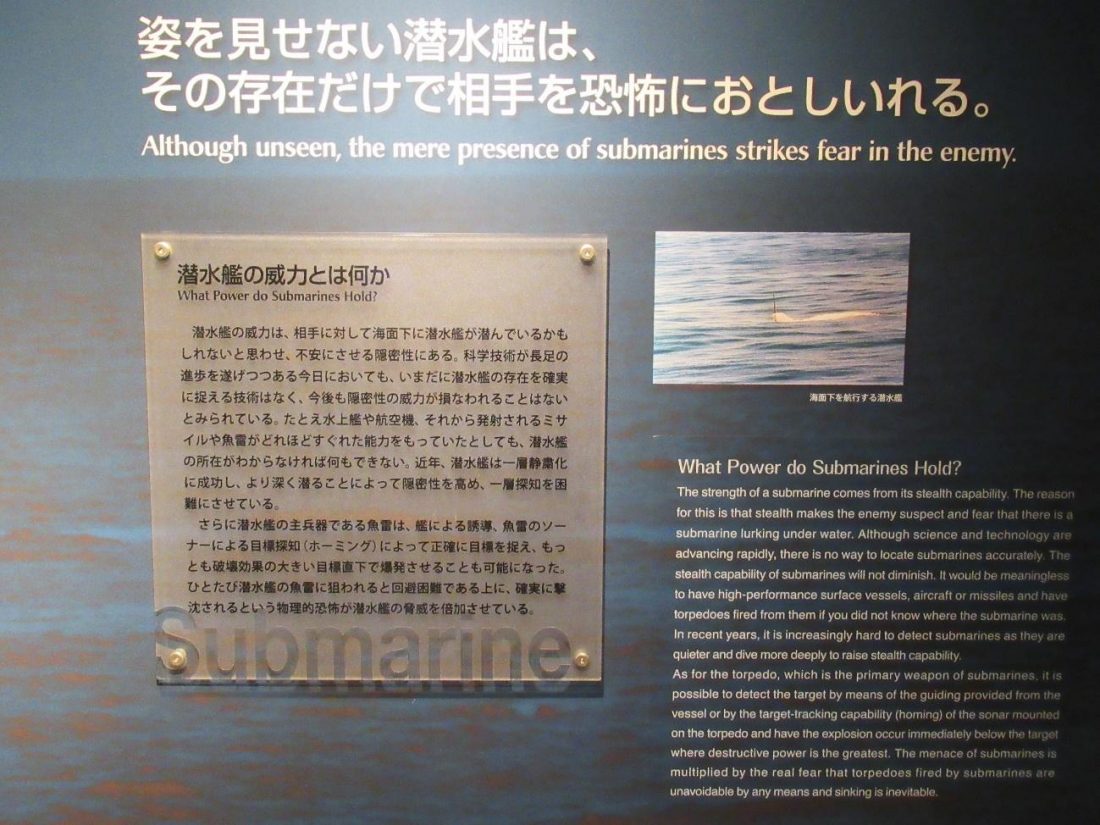
Continuing along the exhibit route, I proceeded into the iron whale where I caught a glimpse of the various rooms inside a JMSDF submarine and got a feel for the tight quarters. Visitors are told not to touch most things onboard, but they are free to take a peek into the periscope in the control room to see what can be seen outside the sub. The exhibit resumes after leaving the sub, leading me into a room filled with Japanese military insignias and recruitment ads for the Japan Ground, Marine, and Air Self-Defense Forces geared toward adolescents, especially girls. From here, I went downstairs to the first floor, where the gift shop and café are, drawing my visit to a close.

The gift shop features souvenirs centered around the JMSDF like cookies with pictures of naval war machines printed on them, nautical apparel, and packs of the quintessential navy curry every Japanese seaman knows too well. I didn’t buy any gifts, but decided to have a midday snack at the café, where the staff were eager to promote their concessions. Visiting the museum costs nothing, so this is probably one of their main avenues for generating profit, but the hospitality was welcome nonetheless. One of their specials is the “Akishio Curry,” a curry and rice dish with the rice shaped like their very own Akishio submarine and made to look like it’s emerging from the surface of the curry ocean. Besides being reasonably priced and popular, they only make ten plates a day, but alas, as it wasn’t lunch time, I had to resist their upsell and settled for a simple cup of green tea soft serve ice cream. My dessert came topped with a print cookie that’s sold in the gift shop and a toothpick bearing international maritime signal flags for decoration. Apparently, the top flag says, “You are running into danger,” and the bottom flag says, “I require medical assistance.”
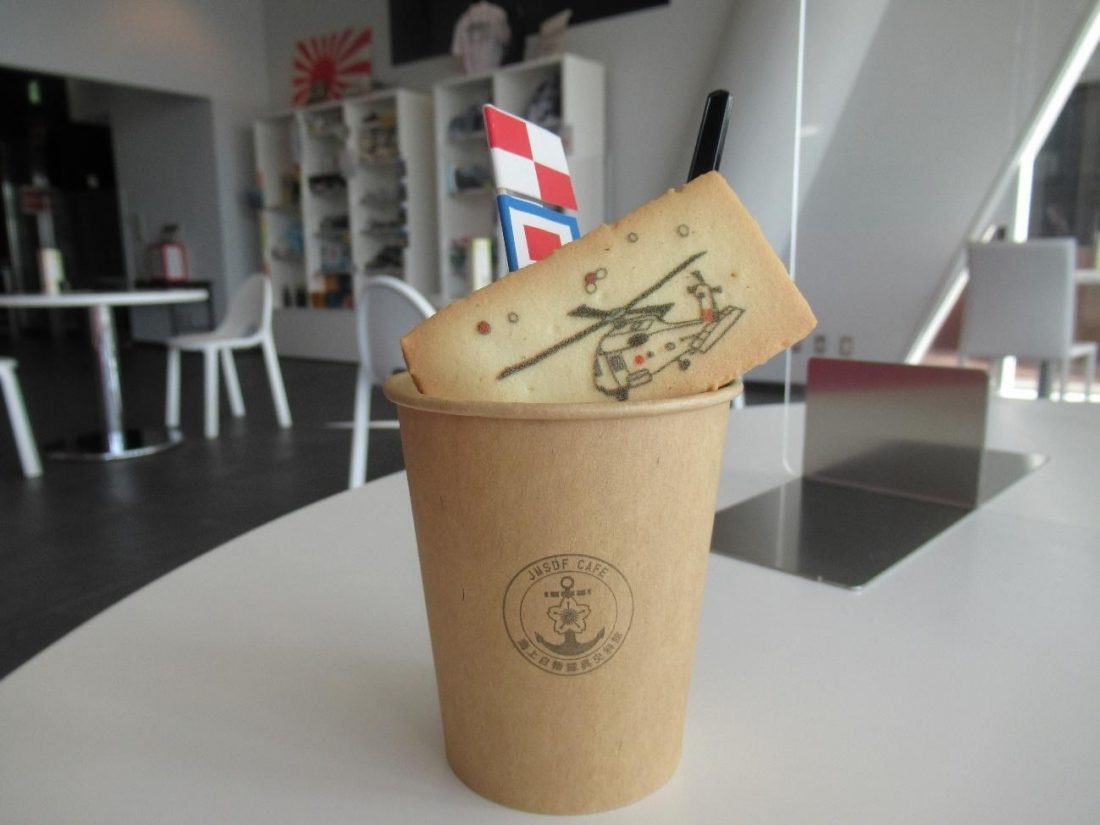
Eating Like Sailors
Despite turning down curry at the JMSDF Museum, I still wanted it for lunch, so in the afternoon I decided on some old-fashioned navy curry at the Haikara Cafeteria, located in a building east of YouMe town on the second floor. The interior is submarine-themed, the staff are dressed in sailor uniforms, and key items on the menu pay homage to the navy or historical battleships. I skimmed over the menu and went for something simultaneously familiar and exotic: submarine curry and rice topped with whale cutlets.
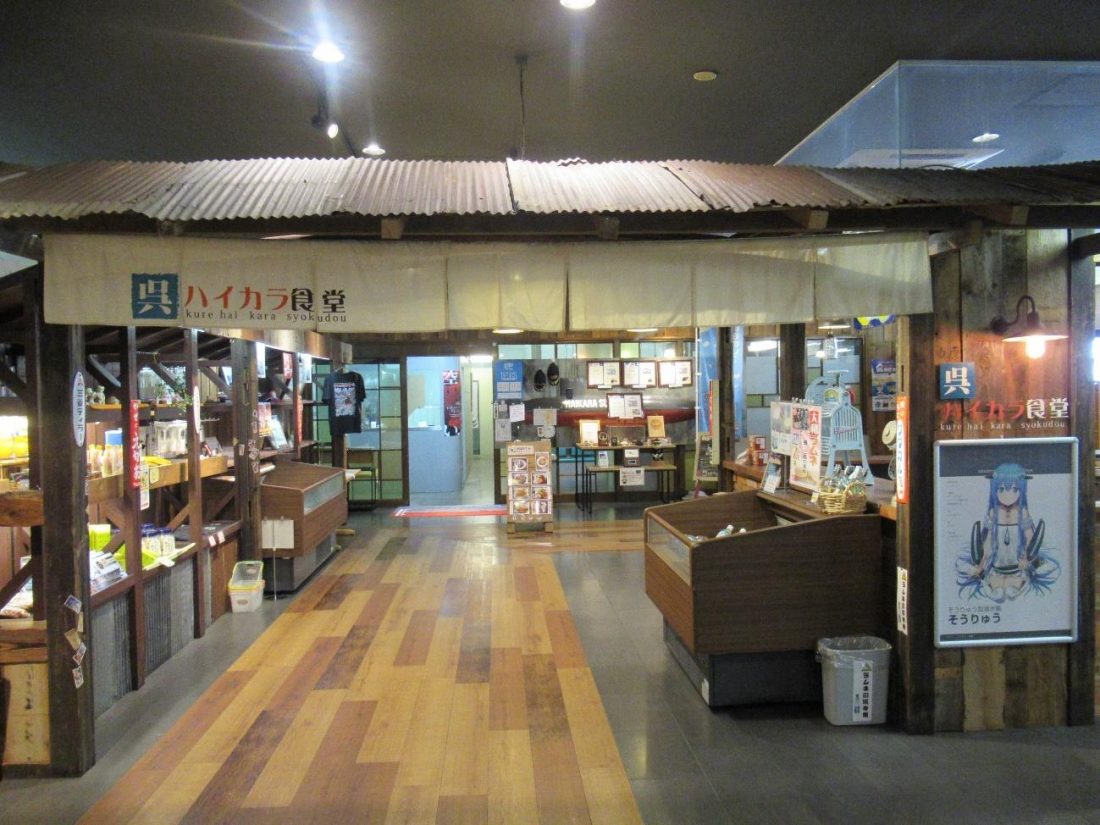
Minutes later, my whale curry and salad came to the table, garnished with broccoli, baby corn, and Japanese-style pickles to jazz up the otherwise monotonous taste. I knew all this time that some Japanese people eat whale, but after years of living here and seeing it canned and sold at markets, I had never tried it even once. However, after being intrigued by the submarine lifestyle and inspired by the resilience of the crew, I was determined to try this marine meat and hastily dove into the meal.
Moment of Joy: Iron Whale of a Tale
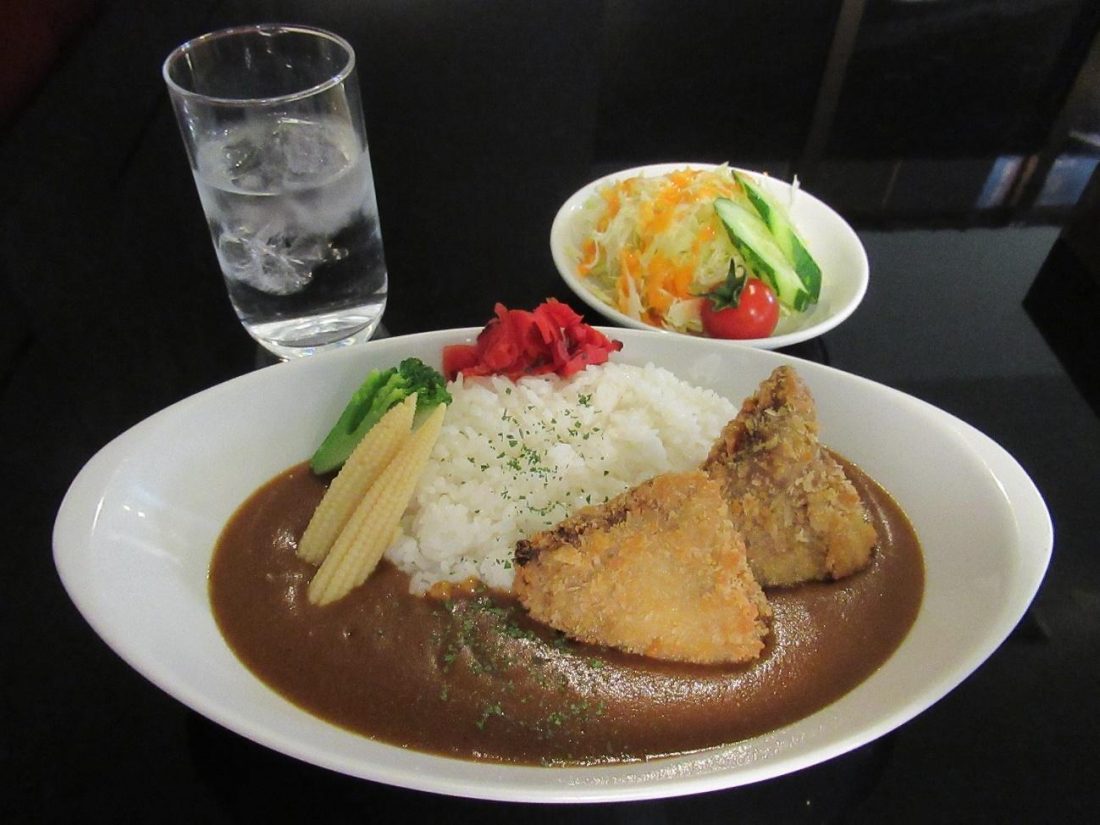
If the menu hadn’t listed the item as fried whale, I might’ve mistaken it for really nasty steak tempura. The whale meat underneath the breaded coating had the texture and appearance of beef, but as I was chewing on it, I could sense a ferric aftertaste reminiscent of canned tuna. When I was paying for my meal, the lady at the register chatted me up and I shared my impressions of eating whale. She stated that the initial odor and funky taste of whale meat tend to drive away most people, but once one acclimates to it, whale can be quite palatable, just as I found it. Then she asked me if I was from around these parts, to which I replied that I was visiting from Hiroshima City and that I had a harbor cruise to catch. It was delightful knowing that trying one local specialty could be such a smooth conversation starter and make me feel more in tune with the Kure lifestyle.
Sightsee at Sea
I made my way to the Kure Central Pier Terminal where I obtained my ticket for a ferry tour of the shipyard around Kure Harbor. Reservations can easily be made on the Bunker Supply boat company website (Japanese only); there are five cruises per day on weekdays (none on Tuesdays) and six per day on weekends and national holidays. The tour takes place on the deck of a small ferry, and while there were about thirty of us that day the deck can accommodate many more.

We spent roughly thirty-five minutes on the boat, and all the while a tour guide gave us the lowdown on every vessel we encountered, most of which were moored JMSDF battleships still in commission. He interspersed his explanations with jokes—some funnier than others—from time to time, catching us off guard to hold our interest. At select points during the cruise the ferry also stopped, allowing tourists to take optimal photos and videos of these grandiose ships. It gets pretty windy onboard so the only times I could get video footage of the shipyard without garbled audio was when our boat was stationary.
The JMSDF exists to defend Japan’s waterways from danger, but since foreign warships aren’t exactly attacking Japan anymore, these days the JMSDF exists to protect the Japanese economy by securing ports and trade routes. This was made evident by the sailors we watched going about their day-to-day work on the ships and subs we passed by. One submariner who happened to have stepped out even waved to us as we approached. In addition to warships, there are also freight ships docked in Kure that carry tons of goods that account for approximately ninety percent of Japan’s imports. With that amount of precious cargo concentrated in one place, it’s easy to see why keeping the battleships and submarines in commission is necessary.
The Mothership Yamato
Following the end of the tour, I disembarked and proceeded to the Kure Maritime Museum, an iconic landmark of Kure that houses a one-tenth scale model of the legendary battleship Yamato. Upon buying my ticket from the vending machine and before even presenting it to enter, I caught sight of the colossal model ship. It’s the first thing visitors see before entering the exhibit area and the last thing they see before leaving the museum, making a lasting impression of the immensity of the largest battleship in history. This so-called miniature is so large that it cannot fit into a single photo at eye level, and it takes a while to walk around the thing too. It’s the highlight of the entire museum and the reason why this place is oftentimes called the “Yamato Museum.”
The exhibition tells of Japan’s nautical history, specifically emphasizing Kure’s role as a principal naval district alongside Yokosuka, Sasebo, and Maizuru. The Kure Naval District was established in 1889 and was tasked with overseeing the waters of the Seto Inland Sea as well as the ocean bordering Shikoku and parts of Kyushu. This section takes visitors through the decades, mentioning how Kure grew as a shipbuilding town, built vessels that fought in the Russo-Japanese War, suffered under the arms limitations of the Washington Naval Treaty, and secretly planned to build the gargantuan Yamato and deployed it in battle until it was sunk in World War II. They even have a short film showing an expedition that found the wreckage at the bottom of the sea and how far apart the bits and pieces scattered. The history tour ends with Kure’s postwar recovery and its interactions with the rest of the world in contemporary history.
The historical displays are rich in videos, informational plaques, and artifacts, but few of the descriptions are in English and photography is not allowed in this hall. Luckily, there is a dedicated app that can be downloaded via QR Code that serves as a multilingual audio guide to compliment the displays, fit with additional pictures and text. Furthermore, some parts of the museum are even compatible with the Nintendo DSi or 3DS through a special guidance app that can be downloaded onto the game system on site.
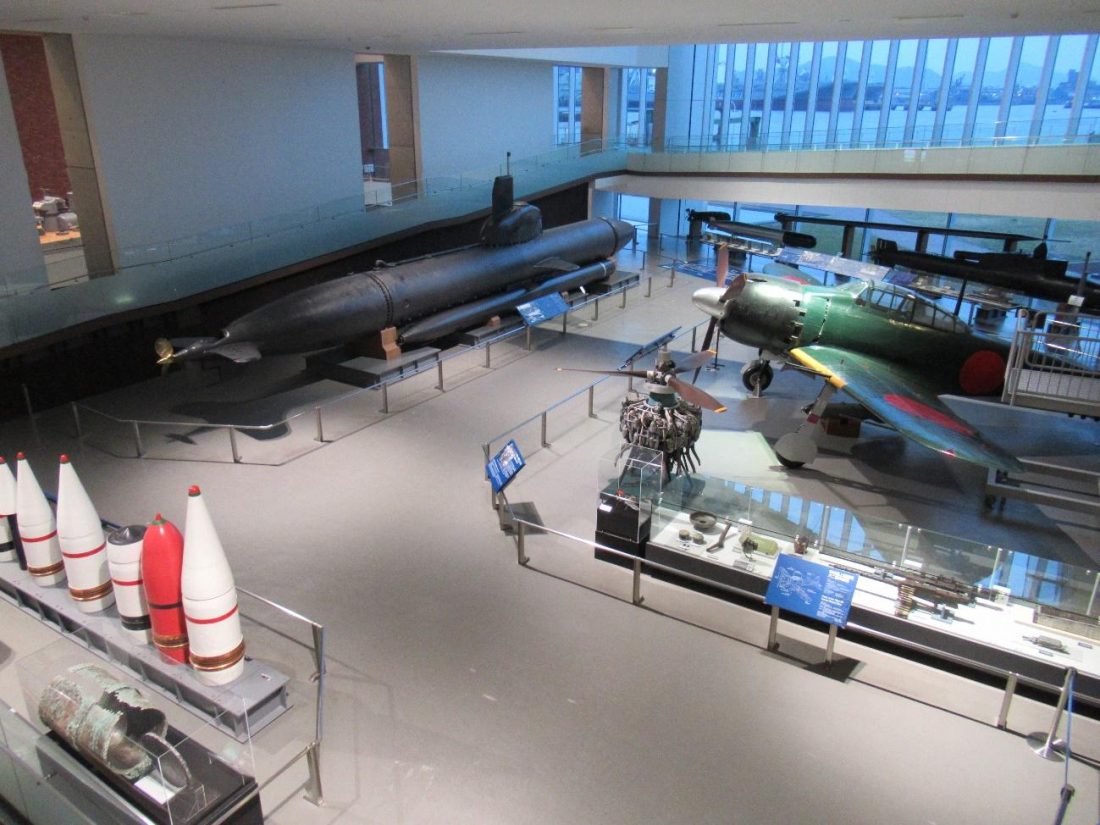
Finished with the history part, I walked past the model Yamato to the other side, which has an array of impressive weapons on display, such as torpedoes, shells, engines, and even a Zero fighter plane. The end of this room leads to an inclined walkway that wraps around the room and allows for a bird’s-eye view of everything. Continuing along, I found a display on my left with even more model battleships before coming out into the central plaza, where I could marvel at the model Yamato from above. The exhibits on the upper floors happened to be closed when I visited, so I instead simply took my sweet time admiring this enormous replica. I could take the best pictures close to closing time when the place was mostly devoid of people, and when I got my fill, I departed the museum.
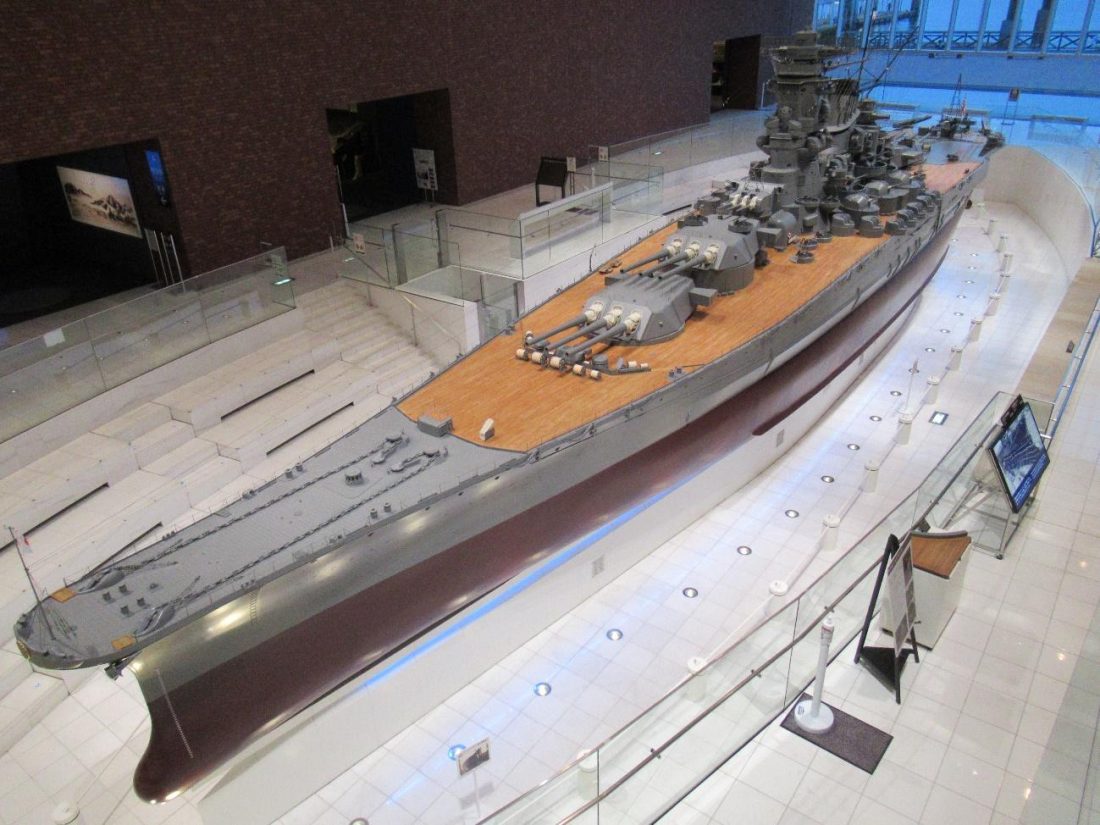
The fun doesn’t have to stop when the museums close, as visitors may still catch the sunset at the harbor park right outside, depending on what season one visits. There’s also a great variety of dining options to be found at YouMe Town and around Kure Station so having dinner before heading back to Hiroshima is more than feasible. Kure Port may only be a small section of the city itself, but the harbor area alone lasted me the whole day, and I strongly believe a day trip to maritime Kure is worthwhile. I would especially recommend it to military and history buffs who would be ecstatic about seeing real Japanese battleships and submarines close up, but kids can get a kick out of the museums too, making it a perfect travel destination for families as well.
Members of the Self-Defense Forces take an oath to put their lives on the line for the livelihoods of everyone in Japan, and thanks to this selfless sacrifice, I am able to enjoy my daily life and adventures around Hiroshima. In return, I would stalwartly defend and advocate Kure as a tourist destination, not to be missed by anyone in the Hiroshima area. As a bastion keeping the wonderland that is Japan afloat, Kure is a seaside treasure waiting to be discovered by tourists, so those who stop by this corner of Japan should set a course for Kure Port!

